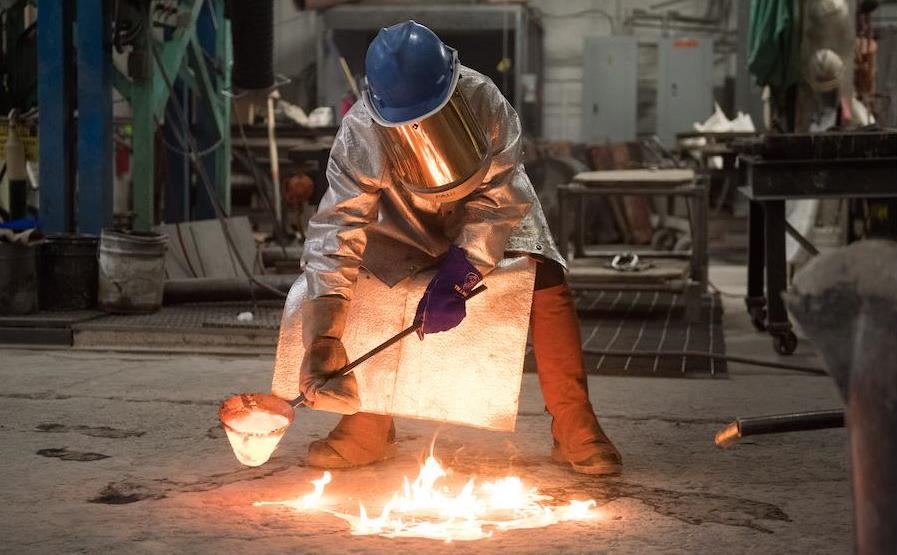Many in the art world will have encountered Lindy Lee’s work over her 40-year career, or perhaps knew her as a founding member of the 4A Centre for Contemporary Asian Art, as the sitter of last year’s Archibald Prize winning portrait, or was once one of her students.
The thing about Lee is she has always, in her gentle way, opened up conversations on identity and notions of belonging for many, oscillating between a matter-of-factness and a deep spirituality in her work.
For many, this survey could be considered long overdue – the most comprehensive journey across her career from the mid-1980s to her current experiments in ‘flung’ molten metals, and room-sized installations that bring the viewer one with universal elements.
Some 70 artworks have been corralled together by MCA Director Elizabeth Ann Macgregor, and curator of this exhibition. She described: ‘This show is everything that should be right for this world now, where we have respect for each, we learn from each other, where identity is a crucial part of who we are, and now, when that moment of connection is so important [for humanity].’
Titled Moon in a Dew Drop, it has been taken from a collection of writings by 13th-century Zen monk and philosopher, Dōgen, and frames Lee’s journey that fleshes out her Australian and Chinese heritage, and a found sense of universality that her practice of Daoism and Ch’an (Zen) Buddhism has gifted.
In Australia we have this idea that the original is best, but there is another experience of the copy, and that is that in the flaws of the copy we can find who we are.
Lindy Lee, 2020
From the outset walking into this exhibition at the Museum of Contemporary Art Australia (MCA), the viewer is introduced to the incredible breadth of Lee’s practice – a suite of Xerox photocopy works from the mid-1980s explore identity via the lens of European masters – the gongs of art history and authority at a time when the conversation of appropriation and the original were heightened.
They sit alongside new bronze works, Buddhas and Matriarchs and Strange Condensations (2020), comprising of over 190 sculptures created by hand-pouring molten bronze; their precious glow on charcoal grey walls hint at an alchemy at play.
.jpg)
Lindy Lee, The Silence of Painters, 1989, Museum of Contemporary Art, gift of Loti Smorgon AO and Victor Smorgon AC, 1995.
Lee said of herself: ‘When I first photocopied work something happened – a clunk inside my gut. In Australia we have this idea that the original is best, but there is another experience of the copy and that is that in the flaws of the copy we can find who we are. And the copy felt like me; I am such a crap copy of China and I’m a really crap copy of white Australia.’
The viewer then journeys chronologically through Lee’s practice as she turned to her Chinese heritage. Her first trip to China saw her studying calligraphy, which turned to the use flung ink – a mediation that would remain across her practice over the next three decades, regardless of material.
A powerful work here is Birth and Death (2003), an installation of 100 accordion books laid out on the gallery floor depicting five generations of Lee’s family, and in a palette restricted dramatically to red and black.
Things really started to come together for Lee in 1995, and the large end gallery demonstrations a fusion of thinking. Key is the installation No Up, No Down, I Am Ten Thousand Things, recreated from its original showing at the Art Gallery of NSW that year.
Over 1000 sheets of paper are flung on the walls and floor – a composite of the portraits, ink works and explorations in Zen thinking.

Lindy Lee, No Up, No Down, I Am the Ten Thousand Things 1995/2020, installation view MCA. Photo ArtsHub.
Lee explained that Zen practice is concerned with self, rather than identity, and that we are a composite of the 10,000 things we encounter in our lives, which defines who we are. She described it as ‘an ongoing project’.
It was the first time that Lee took her work into a 3D engagement – now a physicality that is so embedded in her making. This is demonstrated in the last two galleries of the exhibition – the first an immersive artwork created from suspended sheets of reinforced paper that cast dramatic shadows across the gallery walls, Moonlight Deities (2019–20); and the last gallery a collection of her perforated metal wall scrolls and bronze scholar rocks.

Moonlight Deities (2020), installation view MCA. Photo ArtsHub.
Experiencing Moonlight Deities, the viewer seemingly becomes part of the work; your shadows inter-mingling with those cast by the installation. It is the same with a major new sculpture that sits outside the gallery on the harbour foreshore. During the day, one is reflected into the mirror surface of the sculpture, while at night light emanates form its thousands of tiny perforations casting a dancing light across your body with a magic alchemy.
Secret World of a Starlight Ember (2020) measures over 5-metres in width, and represents the latest development in Lee’s practice.
Overall, this is an entrancing exhibition. It is not ostracising or bombastic in a racial or anti-colonialist conversation. Rather it uses beauty as a mechanism to usher the viewer to find their own place for understanding.
Central to much of the work is the cosmos and the elements of fire, water and air – unifying elements that don’t speak of skin colour, boarders, arrival dates, or heritage – but a place of universal belonging. One doesn’t have to be familiar with Buddhist philosophy to feel the impact of these ideas.
This is timeless; we are timeless, is Lee’s message at a time when we most need to find connectivity and celebrate humanity.
5 out of 5 stars ★★★★★
Museum of Contemporary Art Australia
Curator: Elizabeth Ann Macgregor
2 October 2020 – 28 February 2021





